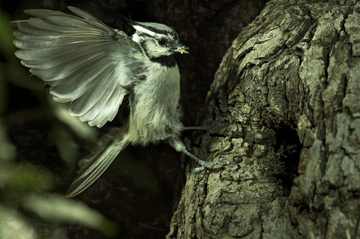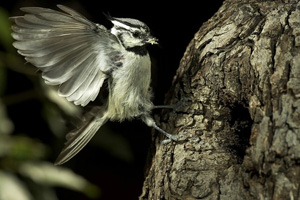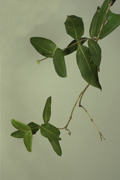


Well, to date, D-E-C or Digitally Enhanced Compositions doesn't exist as an official name, but the fact that image editing programs can fine-tune an image, or can totally change the truth of an image makes some type of labeling system imperative. Years ago, the North American Nature Photography Association spent many contentious hours debating the 'captive animal issue,' and a labeling system that would identify wild subjects from captives. That labeling system is now followed in one form or another by Ranger Rick Nature Magazine, National Wildlife, Nature's Best, and other magazines, with a circled P or the word captive added behind a credit line.
Digital imagery is becoming more and more popular and is becoming the prefered method of shooting for a heck of a lot of great shooters. The BBC's prestigious Wildlife Photographer of the Year contest now accepts digital images, and several winners in 2004 were made on digita. In that competition it is legit to use levels, curves, some color enhancing, sharpening, and cloning to clean up dirt or smudges, and provided the RAW file is included to check for authenticity, all of this is OK.
However, I have addressed the issue of digital manipulation previously as it applies to the non-disturbance of animals - see Is Digital Manipulation - a benign alternative to interacting in the natural world? With this question, I'd like to take this further. In the above two examples, there have been some changes made that may enhance the image. With the bridled titmouse, I added a very subtle amount of background detail that was visible behind the bird that could not be shown if I wished to use electronic flash to freeze the titmouse as it flew into the nest hole. Because of the nest position, and the fact that adding a background that I could have illuminated with flash would have potentially impacted upon the birds' behavior, I let the background go black. I could have added a fake background, as is commonly done for hummers, or I could have added a flash or two to the background to illuminate distant leaves, but I didn't. As stated, a background may have bothered the birds and adding flashes would have been impractical in this situation -- but both methods could have been done.
Instead, in Photoshop, I added a background that provided just a small amount of background, hopefully to reenforce that the bird flies by day and not by night. In this case the addition is so subtle it may not even be necessary (see the original, left, compared to the DEC shot, right), but I did so to make this point and to produce some discussion.


With the broad-billed hummingbird image, a bit more enhancement occured, as I cloned out the feeding tube that the honeysuckle flower partially hid. Hummers are the perfect illustration of the point I'm making -- for almost all hummingbird photos made are very much manipulated, even when shot with film. Consider. The birds are illuminated by an artificial light source - flash. They're coming in to a feeding tube that is usually hidden, or to a plant where sugar water has been injected into the flower. The plant or flower is placed at a bait site or set. Backgrounds go black when flash is used unless either illuminated by flash, which is impractical, or unless a fake background is added and flashed. Most -- I'd bet 90% -- of the hummingbird shots you see are made against a fake background. So, one could say that the only thing 'real' about a hummingbird photo is that the bird was wild and free flying!

 Does
it, then, change the integrity or truth of the image when a feeding
tube is cloned out, rather than cleverly disquised? One could
certainly say that the latter requires more talent and effort,
but nevertheless the results are the same visually. In this example,
where the tube is cloned out, there truly is nothing 'real' other
than the bird -- the flower was a prop at the feeder, the background
is a blown up, out of focus flower garden, sugar water was the
bait, and flash was used!
Does
it, then, change the integrity or truth of the image when a feeding
tube is cloned out, rather than cleverly disquised? One could
certainly say that the latter requires more talent and effort,
but nevertheless the results are the same visually. In this example,
where the tube is cloned out, there truly is nothing 'real' other
than the bird -- the flower was a prop at the feeder, the background
is a blown up, out of focus flower garden, sugar water was the
bait, and flash was used!
Regarding backgrounds, as in the titmouse or with the hummer, does it matter when a background is placed? Had I had the forethought, I could have photographed a field or an Arizona canyon landscape and had that image printed, which I could then place behind the hummingbird as my background. This IS done all the time. However, is there a difference between doing this at the moment of exposure, or doing so later in Photoshop? In either case, folks, it is a fake background and the issue is merely when is it placed behind the hummer.
I don't have answers, well ... maybe one. And that is, just as many amongst us now add 'captive' to our labels when we shoot and caption a captive animal or a controlled animal, perhaps adding DEC would be sufficient to label an image that has been enhanced digitally, while not altering in any way the truth of the image.
Think of examples. A background 'hotspot' that distracts, or a blurred branch that protrudes into a scene, or a portion of another animal that juts within the frame. We'd have these out if we could, doing so by reframing or timing our shot a bit better, but we didn't, or couldn't. In the past, some of these mistakes were simply cropped out if we printed, but now we have new tools (mainly Photoshop) that accomplish the same results.
Anticipating that this issue will eventually be addressed, I encouraged our participants on our hummingbird shoots to shoot hummers with the feeding tube visible. In most cases, the participants were not selling photos but were merely interested in making a great print they could hang on their wall. By having complete freedom in positioning a feeding tube we were able to maximize our compositional freedom, and our chances of catching the irridescence of the gorget of a hummingbird; something often not possible when a bird's flight and a camera's position are dictated by the need to hide a feeding tube.



Admittedly, this last example pushed the envelope of DEC but nonetheless illustrates my point. I could have made this shot 'straight' by hanging honeysuckle leaves and flowers, or by photographing the flowers and making a print that I could position behind the bird. I could have hidden a feeding tube or so conditioned a hummer to a feeding tube location that it may have visited a honeysuckle hung in the same spot for at least one visit. I didn't, though, and this shot was made as the bird drank from a feeding tube, and 'composited' later.
So, here's some food for thought, discussion, and debate. And, just for the record, although I now shoot digital I have not made a composite image, a DEC shot, that I've offered for sale in an editorial market, or to any market. When I do, and I will, I will use a label like DEC to identify these shots, and my point, here, is simply to speed up the standardization of the process. At least three pro photographers that I know of have done DEC-type work. One was really fried in doing so, another is in the process of being cooked (especially by overseas critics), and the other, who was rather upfront about the procedure, didn't create a ripple of dissension. So, let's adopt a standard, let's adopt DEC!
|
|
|
|
Flash-Remotes |
|
NANPA |